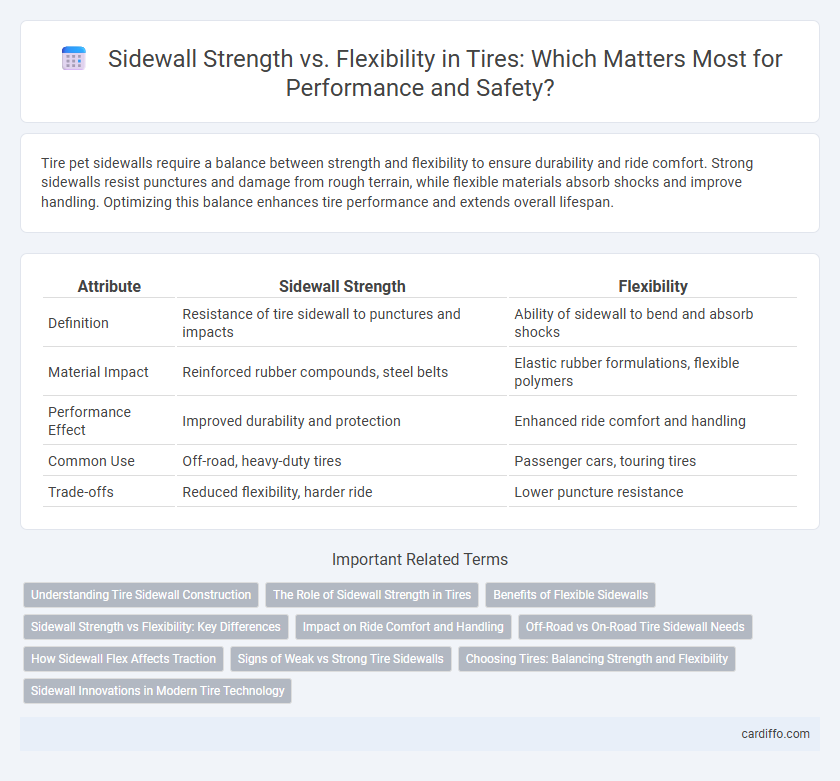Tire pet sidewalls require a balance between strength and flexibility to ensure durability and ride comfort. Strong sidewalls resist punctures and damage from rough terrain, while flexible materials absorb shocks and improve handling. Optimizing this balance enhances tire performance and extends overall lifespan.
Table of Comparison
| Attribute | Sidewall Strength | Flexibility |
|---|---|---|
| Definition | Resistance of tire sidewall to punctures and impacts | Ability of sidewall to bend and absorb shocks |
| Material Impact | Reinforced rubber compounds, steel belts | Elastic rubber formulations, flexible polymers |
| Performance Effect | Improved durability and protection | Enhanced ride comfort and handling |
| Common Use | Off-road, heavy-duty tires | Passenger cars, touring tires |
| Trade-offs | Reduced flexibility, harder ride | Lower puncture resistance |
Understanding Tire Sidewall Construction
Tire sidewall construction balances strength and flexibility by using reinforced materials such as polyester, steel, or aramid fibers to provide durability against impacts and abrasions while allowing necessary flex during cornering and shock absorption. The sidewall's layered composition, including belts and plies, contributes to maintaining structural integrity under load without sacrificing ride comfort. Understanding this balance is crucial for optimizing tire performance, safety, and longevity in various driving conditions.
The Role of Sidewall Strength in Tires
Sidewall strength in tires directly impacts durability and resistance to punctures or damage from road hazards, ensuring longer tire lifespan. Enhanced sidewall strength also improves vehicle stability and load-carrying capacity, especially important for heavy-duty and off-road tires. Balancing sidewall strength with flexibility allows tires to absorb shocks while maintaining optimal performance and comfort.
Benefits of Flexible Sidewalls
Flexible tire sidewalls enhance ride comfort by absorbing road imperfections and reducing vibrations transmitted to the vehicle cabin. Increased flexibility also improves traction by allowing better tire contact with uneven surfaces, enhancing grip and control. Moreover, flexible sidewalls contribute to durability by distributing stress more evenly, minimizing the risk of sidewall damage and extending tire lifespan.
Sidewall Strength vs Flexibility: Key Differences
Sidewall strength in tires provides enhanced protection against impacts and punctures, essential for off-road and heavy-load applications, while flexibility contributes to a smoother ride and better handling by absorbing road irregularities. Strong sidewalls are typically constructed from reinforced materials such as steel belts or high-density rubber compounds, offering durability at the expense of some ride comfort. Tires with more flexible sidewalls, often found in passenger and performance vehicles, prioritize comfort and traction but may sacrifice some resistance to damage under harsh driving conditions.
Impact on Ride Comfort and Handling
Sidewall strength in tires directly influences handling stability by reducing lateral flex during cornering, enhancing precise steering response. However, increased sidewall rigidity can compromise ride comfort by transmitting more road vibrations to the vehicle cabin. Conversely, flexible sidewalls absorb shocks and uneven terrain better, improving comfort but potentially sacrificing some handling sharpness and vehicle control.
Off-Road vs On-Road Tire Sidewall Needs
Off-road tires demand sidewalls with exceptional strength to resist punctures, cuts, and abrasions from rocks and debris, ensuring durability in rugged terrains. On-road tires prioritize sidewall flexibility to enhance ride comfort, improve handling, and absorb road imperfections on paved surfaces. Balancing sidewall construction materials and design caters to the specific performance requirements of off-road toughness versus on-road smoothness.
How Sidewall Flex Affects Traction
Sidewall flexibility directly influences tire traction by allowing the tire to maintain better contact with uneven road surfaces, enhancing grip and stability. A flexible sidewall can absorb shocks and adapt to road irregularities, improving traction during cornering and braking. Conversely, overly stiff sidewalls may reduce traction by limiting tire deformation, causing less surface contact and a harsher ride.
Signs of Weak vs Strong Tire Sidewalls
Strong tire sidewalls exhibit minimal bulging and resist punctures, providing enhanced stability and durability under load. Weak sidewalls show visible cracks, excessive flexing, and sidewall bubbles, indicating compromised structure and increased risk of blowouts. Identifying these signs ensures proper tire performance and safety on various terrains.
Choosing Tires: Balancing Strength and Flexibility
Selecting tires requires balancing sidewall strength and flexibility to optimize performance and durability. Strong sidewalls enhance resistance to punctures and side impacts, essential for off-road or heavy-duty driving. Flexible sidewalls improve ride comfort and traction by absorbing road irregularities and allowing better tire deformation during cornering.
Sidewall Innovations in Modern Tire Technology
Modern tire technology emphasizes advancements in sidewall strength and flexibility to enhance performance and safety. Innovations such as reinforced rubber compounds and multi-layered sidewall structures provide superior puncture resistance while maintaining optimal flexibility for improved ride comfort and handling. These developments contribute to longer tire lifespan and better adaptability across varying road conditions.
Sidewall Strength vs Flexibility Infographic

 cardiffo.com
cardiffo.com